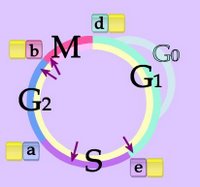Enzymes
Endothermic reactions, such as the steps in biosynthesis of macromolecules, require heat input, while exothermic reactions release heat. Thermochemistry deals with the heat exchange of chemical reactions, while reaction energetics deals with the dynamics of chemical reactions.
Although enzymes alter k, the rate of a reaction, they do not alter Keq, the actual equilibrium point. However, if the products of a reaction are removed by a second reaction, then the product side of the reaction equation will be favored because equilibrium tends toward maintaining the ratio of products to reactants.
Constitutive enzymes are always produced at roughly the same concentration regardless of the composition of the medium (glycolysis, TCA cycle). Conversely, inducible enzymes are produced in response to a particular substrate, being produced only when needed. In induction, the inducer substrate, or a structurally similar compound, promotes formation of the enzyme. Conversely, the production of repressible enzymes downregulated by environmental conditions, such as the presence of the end product (corepressor) of a pathway in which the enzyme normally participates.
Regulation of enzymatic function:
Enzymes often function in metabolic chains in which regulation occurs by specific feedback mechanisms. Individual metabolic reactions are typically managed in the forward and reverse directions by structurally distinct enzymes, which permits regulation of metabolic pathways.
In bacterial cells, regulation of enzymatic reactions proceeds by:
1) control or regulation of enzyme activity by feedback inhibition or end product inhibition, which regulate biosynthetic pathways, or
2) control or regulation of synthesis of inducible or repressible enzymes, by
a) negative control as end-product repression, which downregulates enzyme synthesis and associated biosynthetic pathways,
b) positive control as enzyme induction and catabolite repression, which upregulate enzyme synthesis and associated degradative pathways
Metabolic regulation is often implemented through allosteric enzymes, which possess, as do allosteric proteins, multiple shape-changing subunits with distinct active sites. Allosteric enzymes change shape between active and inactive forms in response to the binding of substrates at the active site, or to binding of regulatory molecules at other sites. Because the reaction rates of allosteric enzymes can be regulated by only small changes in substrate concentration, allosteric enzymes are employed by cells to regulate metabolic pathways in which the concentration of cellular substrates fluctuates over narrow concentration ranges. In the simplest case in which an allosteric enzyme with a positive effector site has an active and an inactive form, the alteration in reaction rate in response to increasing substrate concentration typically displays an "S-shaped" curve. After binding of a molecule to the positive effector site of an allosteric enzyme, the second and subsequent substrates bind readily because binding of the effector molecule has induced a favorable structural change. This response is termed "cooperativity," and the S-shaped curve indicates the cooperative binding of substrate. Conversely, for allosteric enzymes with negative effector sites, binding to the allosteric site inactivates further substrate binding to the active site.
MIT Biology Hypertextbook: Enzyme Mechanisms: "Not all proteins are enzymes, but most enzymes are proteins (the exception is catalytic RNA). [Enzymes are catalysts employed in cellular reactions.] A catalyst is a molecule which increases the rate of a reaction but is not the substrate or product of that reaction. A substrate (A) is a molecule upon which an enzyme acts to yield a product (B).
A –––→ BEnz
The free energy of this reaction is not changed by the presence of the enzyme, but, for a favored reaction (where ΔG is negative), the enzyme can speed it up."
Enzymes couple with substrates in transitional states, effecting conformational changes (3D structure) that facilitates transition to products.
The classification and naming of enzymes, according to the EC, depends upon their function in the reactions that they catalyze:
1. EC1. Oxidoreductases alter the oxidation state of molecules by transfer of electrons (often as hydride ions H−).
2. EC 2. Transferases transfer chemical groups from one molecule to another (not to be confused with cofactors which carry groups).
3. EC 5. Isomerases transfer chemical groups within molecules.
4. EC 3. Hydrolases add or remove H2O from molecules.
5. EC 4. Lyases manipulate double bonds in elimination reactions.
6. EC 6. Ligases condense bonds between C- and S/N/C/O, using energy from ATP
Similarly, enzymes such as RNA polymerase are named for their actions, where RNA polymerase is a common name for ATP:[DNA-directed RNA polymerase] phosphotransferase.
Specific enzymes:
DNA polymerases & reverse transcriptase : base excision repair = DNA glycosylase & AP endonuclease & Fen1 protein : hOGG1 DNA repair : helicases : RNA polymerase : ribozymes : ribozymes in repair of RNA and DNA :
Alphabetical: Enzymes →reaction→ A: ~ adenylate cyclases : AP endonuclease (Ape1) : aspartate aminotransferase ~ ATPases ~ : B: base excision repair : C: ~ cyclin-dependent kinases ~ cytochrome c oxidase s: D: DNA glycosylase : DNA Ligase I : DNA polymerases : DNA polymerase I : DNA polymerase beta : DNase IV : E: exonuclease 1 : exosome : F: Fen1 : Flap Endonuclease FEN-1 : G: general transcription factors : glucose-6-phosphate dehydrogenase : →glutamate-dehydrogenase→ : H: hOGG1 : hOGG1 oxoG oxoG repair : L: LigIII : M: MAP kinase : Msh2-Msh3 : MutS, MutL, and MutH : N: NADH dehydrogenase : nucleotide excision repair : O: 8-oxoguanine glycosylase : oxoG oxoG repair hOGG1 : P: PCNA : ~ phosphatases ~ phospholipases ~ phosphodiesterases ~ phosphorylases ~ 6-phosphogluconate dehydrogenase ~ protein kinases ~ pyruvate carboxylase →pyruvate carboxylase→: pyruvate dehydrogenase • pyruvate dehydrogenase reaction : R : ~ receptor tyrosine kinases ~ RNA polymerase : replication : Replication factor C : reverse transcriptase : ribozymes : ribozymes in repair of RNA and DNA : ribulose bisphosphate carboxylase/oxygenase : RNA polymerase II : Rubisco : S: ~ serine/threonine kinases ~ spliceosomal-mediated RNA trans-splicing SMaRT : succinate dehydrogenase : T: transaldolase : transketolase : trans-splicing ribozymes : U: UvrD : X: XRCC1 :
MIT Biology Hypertextbook on Enzyme Biochemistry : Chemical Energetics : Enzyme Mechanisms : Enzyme Kinetics : Feedback Inhibition | 0 Guide-Glossary









































